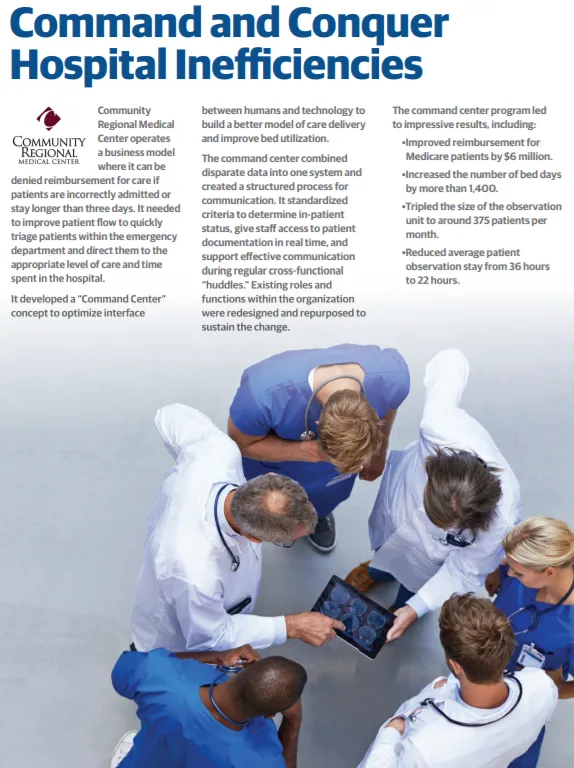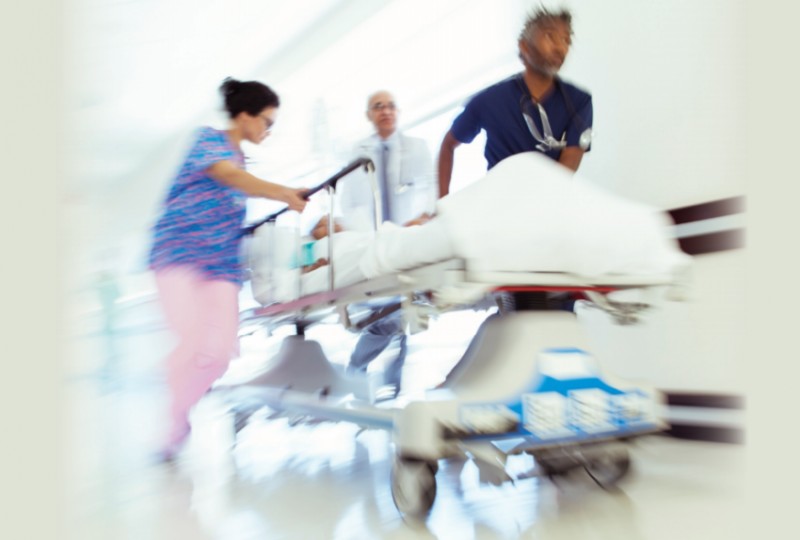Minutes matter in an emergency room, both for patient health and for hospital operations. When you’re the second busiest emergency room in California, time can be a barrier to quality care, but also to insurance reimbursements.
Community Regional Medical Center in Fresno, Calif. serves approximately 2.5 million people for trauma, neuroscience, neonatal intensive care unit, advanced pulmonary care, congestive heart failure, and other care needs. The population is well below the national and state poverty limits, and 55 languages are spoken.
Chief Medical Innovation Officer Dr. Mark Kestner is tasked with evolving models of care and streamlining operations to benefit patient experience as well as administrative efficiency. He leans on a combination of humans and technology to eliminate “white noise” around care and allow patients to have a voice during their stay.
Customer Strategist: What does a Chief Medical Innovatin Officer do?
Dr. Mark Kestner: My scope of responsibility is to change models of care and to respond to the changes in the regulatory and insurance market as they market transitions from fee for service toward risk-bearing contractual relationships. It also is involved heavily in our public perception of the care that we deliver, specifically our star rating and our value-based purchasing rating, which obviously carries with it the public perceptions about the quality of care that they got while they were at our facilities.
CS: What’s your hospital system like?
MK: Community has 909 beds on its campus. It has the 17th busiest emergency room in the U.S., and the second busiest emergency room in California. We at any one time can have up to 200 patients in an emergency room built for 100 patients. Anywhere between 40 and 100 patients are waiting for some type of in-patient or observation services. It is a very challenging socially and economically diverse population that we serve.
CS: What does medical innovation mean to you personally?
MK: I’m constantly challenged to think of ways of doing and delivering care in different models. I spend most of my day looking at and rounding with the team to figure out how we are going to deliver care in a more cost-effective way. We are a two-star rated hospital right now and by the end of the year we need to be a three-star rated hospital. That requires a lot of heavy lifting and a lot of changing the way in which we address our hospital conditions historically.

We must constantly be scrutinizing physician documentation because in a DRG payer environment; we get paid for the stories we tell. We are constantly looking at the ways in which physicians are documenting and querying whether they meant something differently and improving the documentation to ensure appropriate payment for the care that we deliver.
I’m not so much dealing with the individual physicians. I’m dealing with the teams of people that support physicians and nurses, and the model of care that they deliver. I’m constantly looking for duplication and elimination of waste in our system. I have industrial engineers, data analysts who are constantly looking at the way people are working and accumulating the data to determine how we can deliver it more efficiently. It’s a rather unique role.
CS: How does your team’s focus on operational efficiency correlate to the patient experience?
MK: In our system, every patient can give us immediate feedback. We have a system called the Get Well network where they can send out kudos or concerns regarding their care as it’s delivered. That escalates all the way up to my level and we ensure that we are addressing in real time any patient concern or we’re congratulating members of the team that the patient has identified as giving them optimal care.
Unfortunately, because we’re in an underserved area with a lack of resources, most of our patients do wait in the emergency room up to days sometimes for an in-patient bed. When they get into the hospital they’re in a double-occupancy room that’s small. So that means we have to go the extra mile to deliver an optimal patient experience, and we have to look at creative ways to ensuring we’re engaging with the patients from the time they enter our facility to the time they go home.
CS: What are some ways your team goes the extra mile and works creatively to meet these challenges?
MK: First off, we have a highly engaged workforce. There is a strong mission for people who work here to know they work in a unique environment. Our employees are highly engaged, and our engagement scores will support that.
Then, there are lots of challenges in meeting the diverse needs of our patient population. We have over 200 languages available via telecommunications for our patients. And there’s the Get Well network, which allows the patient to engage electronically to register complaints and concerns in real time.
Our clinical executives round routinely, so we have a strong senior leadership presence in our hospital. Our chief nursing officer has worked in the system for 18 years, and she knows she can walk seamlessly through the facility and people know her. I round in the ICUs three to four times a week. I manage the operating room for a period of time. Our doors are always open and our emails are always on if there’s a concern at any level of the organization to address quality of care.
So it’s the combination of engaged employees, engaged leadership, and the electronic tools to engage patients and their families and give real-time feedback. And candidly, it’s the expectation that we’re going to do everything we possibly can to ensure the patient has an outstanding experience.
CS: How do digital and humans work together at Community?
MK: Three times a day we have virtual huddles. The first and last ones are to talk about the barriers to patient flow. All areas of the organization meet at those times and talk about barriers to flow. Prior to that they’re given an email blast that comes out of the command center (see sidebar) that allows them to frame any conversation that we may have.
One huddle every day is focused on safety, where every unit talks about anything that has to do with patient safety. That highly engages the front-line workforce. I’m always on the call, the chief nursing officer is always on the call, senior leaders are on the call. We talk about pharmacy shortages, medication shortages, and other topics. That is a way that our front-line staff know that leadership is highly engaged in problem-solving with them.
We are in the transition of getting our workforce on Vocera [mobile communications devices], which would give them real-time access to communication [via RFID badges and other wi-fi devices], rather than relying on a cell phone. I can wear a badge to speak to anyone as long as I am logged into the electronic medical record appropriately to identify that I am the one taking care of the patient in room 405. This compares to walking around with a telephone hoping that people know my number.
But as we interface with technology, we need to make sure that the workforce understands how to use the technology.
CS: How does technology improve the patient experience?
MK: Most patients don’t have an active voice in their care delivery model. They’re just waiting for somebody to show up, for somebody to deliver care, hoping that their family is there when someone important comes in.
Our system allows the patient to engage with senior leaders immediately, and for us to ensure that they have an active voice in their health delivery model. That’s why things like the command center are so important. Otherwise some of those messages would get lost in the day-to-day operations of the unit and be dependent on the individual delivering the care. This takes that message and sends it out to a broader group of people so that patient voices can be heard.
CS: What have you learned from your experiences that others can take away?
MK: Organizations can only change so fast. You have to recognize that if something isn’t happening at the pace of change necessary, you have to move on to another project, another focus, another way of addressing the issue, or another organization. My constant challenge to myself is to ask, “Have we taken this as far as we can and do we need to now focus the workforce on a different issue in order to continue to improve the model of care we deliver?”
Having that self-awareness to give the organization time to absorb change is important. Otherwise you can really burn out fast trying to make too big of a change globally. That’s important for people to recognize.
CS: What’s on your project wish list this year to continue to make progress?
MK: The big challenge for Community and most of healthcare in the next couple of years is how to engage the workforce in delivering a cost-effective model, as compared to just adding on every new technology and every new toy. We are going to have to be very cognizant of the fact that we can’t do everything. The bigger issue for us going into the future is how do we effectively say no and still improve the quality of care we deliver.
We have to step back and think about how we can do things differently and how can we protect resources to make sure we’re improving the quality of patient care from a global perspective.
*Community Regional Medical Center is a client of TTEC Digital.
















